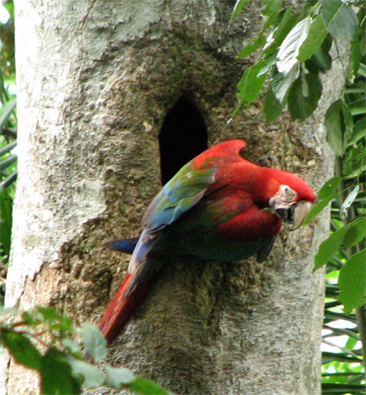More good news, another 3 chicks have fledged for the season, this time all from the 7 islas area. I flew in on New Year’s Eve to relieve some of our field team of duties. One guy had a bad ear infection that required immediate medical attention and some others were simply burnt out from being in the field for over two months. One nest (nest 27, see September 28th entry) had fledged a single chick two days previous but there still remained a nest with two nestlings that was important for me see through to fledging. I saw at least one chick in the nest on January 1st and none the next day. Either they fledged on the afternoon of the first or the early morning of the 2nd. Right after these chicks fledged there was a curious Green-winged Macaw inspecting the cavity. It’s a good nest. No surprise it’s in demand.

The 7 islas area is one of the success stories for our project. When we first visited the area in October 2004, there were two BTM pairs there. They each fledged a single chick that season. In 2005 another nesting pair showed up (the vaca muerta pair) though none of the pairs nested that year. This season a total of three chicks fledged there bringing the total of birds up to nine. On the surface not a big increase but to have the population more than double is a testimony to what we can do when we invest the time managing nesting attempts. Hopefully with an influx of more funding and field staff when can replicate the success we’ve had here in other regions.
After the chicks fledged at 7 islas, I headed over to check on the last nest we have with chicks, the ‘bee hive’ nest. Both the chicks were in good health (decent weight, no ectoparasites, and good energy) and look in good shape to fledge in less than a month’s time.
Of all the nests we worked with this season, this is the one I’m most proud of. After enduring all those bee stings getting the hive out of there in early September, it was gratifying to see the nest become active in mid-October; more so to have chicks fledge from it this year when it failed in 2005. With a bit of gumption we can have a positive effect on this species’ recovery.
About three km (2 miles) north of the bee hive nest, another BTM nesting pair began incubating in late December. Sadly its discovery comes at the tail end of this current field season when project funds have dried up. We’ll have a local check on this nest periodically but we can’t afford it the full protection we’ve given to other nests. I’ve always wondered if there’s a second wave of BTM nesting attempts later on in the breeding season, more in tune with the nesting of other macaw species. Ideally we could have enough money to work year round in order to adequately look after all nesting attempts and getting a better sense of what is happening to chicks once they fledge. The reality is that conservation work in general is always short on cash, so we have to make due with what we funds we do have. In the case of our study that means we can start working in August until early February.
Based on photos I took of the facial feather lines on this pair I was able to determine that the pair from the new nest tried unsuccessfully to nest in a motacu snag that collapsed due to strong winds in 2005. That nest was about 10km away from the nest they’re using in 2006/2007, suggesting that pairs will move around in search of adequate nesting sites. In fact the more I analyze facial photos, the more it seems like a game of ‘musical chairs’ is occurring with BTM nesting trees. Nesting pairs at specific nests change from year to year, rather than having the same pair each breeding season. This is good news from the perspective of a high quality nests, as different pairs will have a chance at using them instead of having certain pairs dominate them year after year.
I also had the chance to check on our nest boxes in the area. Alas two of the boxes were being occupied by Blue and Gold Macaws (BGMs), both of which had small nestlings. In other words, the metal plates we placed over the entrances do no exclude the larger, BGMs. As I’ve mentioned before, we don’t want to encourage the already larger BGM population from growing due to our boxes. Although only two of the 15 boxes we put up were used by BGMs we’ll have to replace all the entrance plates early next breeding season with something smaller to prevent BGMs from using them. Back to the drawing board with the nest boxes!
Finally the two hardwood nest trees I repaired in August (see August 20th entry) are currently active with Chestnut-fronted Macaws. While they are not a target species for our project it’s good to know these nests are being used again and in theory will be available to BTMs for the next breeding season.
































